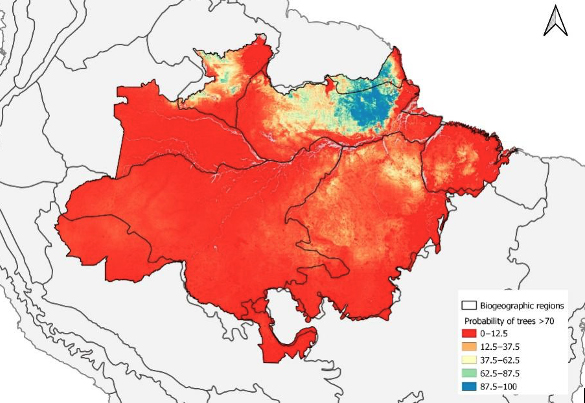March 25, 2021
Resource Availability and Disturbance Shape Maximum Tree Height Across the Amazon
Study indicates changes in wind and light availability drive giant tree distribution.

The probability of giant tree occurrence based on environmental conditions estimated by the maximum entropy model.
[Reprinted with permission from Gorgens, E. B., M. H. Nunes, T. Jackson, et al. “Resource availability and disturbance shape maximum tree height across the Amazon,” Global Change Biology 27(1), 177-189. (2021). [DOI:10.1111/gcb.15423]. © 2020 John Wiley and Sons.]
The Science
Tall trees are key drivers of ecosystem processes in tropical forests, but the mechanisms controlling the distribution of the very tallest trees remain poorly understood. The recent discovery of giant trees taller than 80 meters in the Amazon forest requires re-evaluating current thinking.
The Impact
Researchers from NGEE-Tropics found that changes in wind and light availability drive giant tree distribution as much as precipitation and temperature, together shaping the forest structure of the Brazilian Amazon. The location of giant trees should be carefully considered by policy-makers when identifying important hot spots for conserving biodiversity.
Summary
In this study, a research team used the largest airborne lidar data collection in the Amazon to contribute to the understanding of (1) how resources and disturbances shape maximum tree height distribution across the Brazilian Amazon and (2) what drives the occurrence of giant trees (taller than 70 m). They conducted an extensive analysis relating environmental variables to the maximum height recorded in the lidar transects (see figure). Common drivers of height development are fundamentally different from those influencing the occurrence of giant trees. Results indicate that changes in wind and light availability drive giant tree distribution as much as precipitation and temperature, together shaping the forest structure of the Brazilian Amazon. Ultimately, the association between environmental conditions and mechanisms of natural selection are key to understanding the complexity of this process in a changing climate.
Principal Investigator
Eric Bastos Gorgens
Universidade Federal dos Vales do Jequitinhonha e Mucuri (UFVJM), Brazil
eric.gorgens@ufvjm.edu.br
Program Manager
Daniel Stover
U.S. Department of Energy, Biological and Environmental Research (SC-33)
Environmental System Science
daniel.stover@science.doe.gov
Funding
Funding was provided by the Coordenação de Aperfeiçoamento de Pessoal de Nível Superior Brasil (CAPES; Finance Code 001), Conselho Nacional de Desenvolvimento Científico e Tecnológico (Processes 403297/2016‐8 and 301661/2019‐7), Amazon Fund (grant 14.2.0929.1), National Academy of Sciences and U.S. Agency for International Development (grant AID‐OAA‐A‐11–00012), Universidade Federal dos Vales do Jequitinhonha e Mucuri (UFVJM), and Instituto Nacional de Pesquisas Espaciais (INPE). D. Almeida was supported by the São Paulo Research Foundation (#2018/21338‐3 and #2019/14697‐0). B. Gimenez, G. Spanner, and N. Higuchi were supported by INCT‐Madeiras da Amazônia and the Next-Generation Ecosystem Experiments–Tropics (NGEE‐Tropics) project, as part of the U.S. Department of Energy’s Terrestrial Ecosystem Science Program, Contract No. DE‐AC02‐05CH11231. T. Jackson and D. Coomes were supported by the UK Natural Environment Research Council grant NE/S010750/1. M. Nunes was supported by the Academy of Finland (decision number 319905). J. Rosette was supported by the Royal Society University Research Fellowship (URF\R\191014).
References
Gorgens, E. B., M. H. Nunes, T. Jackson, et al. "Resource availability and disturbance shape maximum tree height across the Amazon." Global Change Biology 27 (1), 177–89 (2021). https://doi.org/10.1111/gcb.15423.

